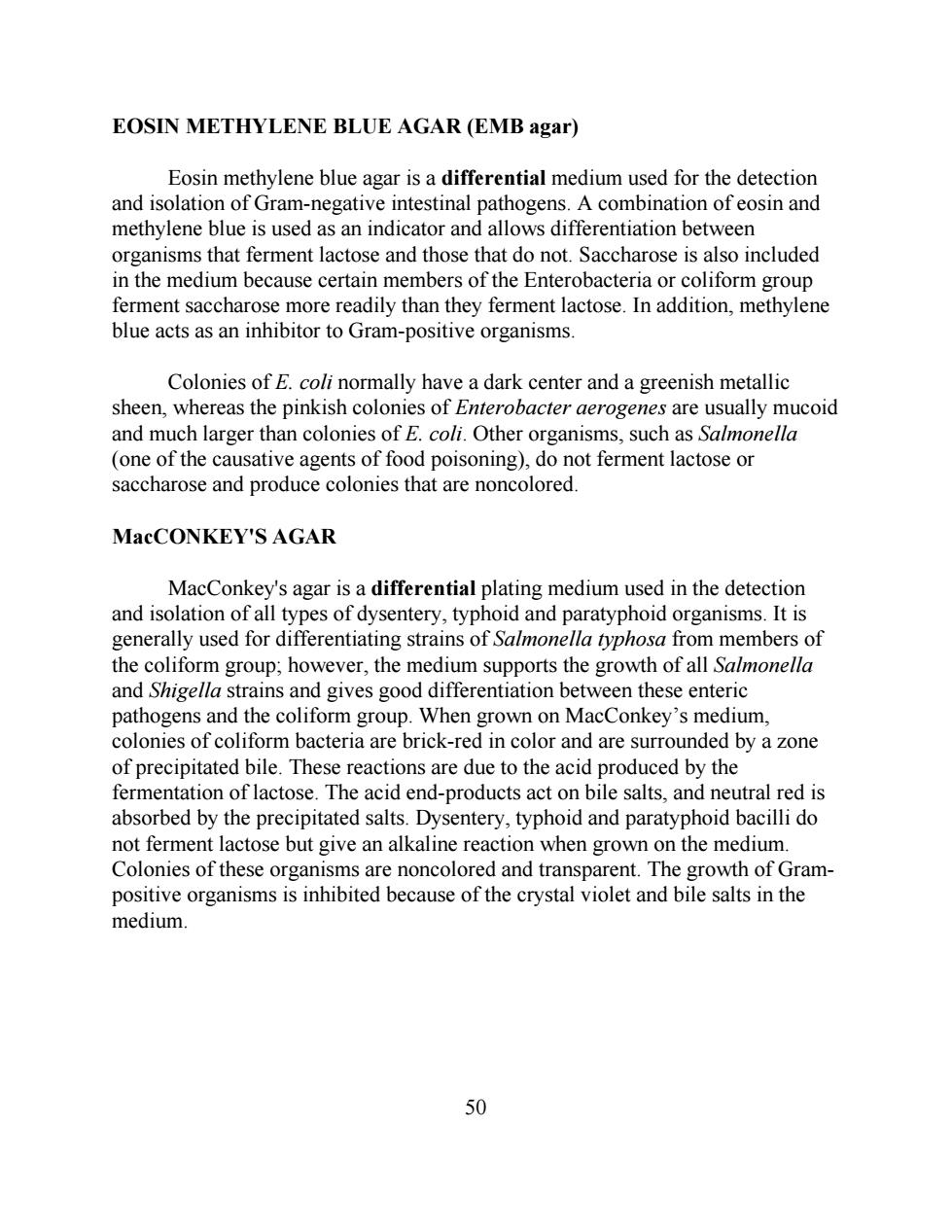正在加载图片...

EOSIN METHYLENE BLUE AGAR (EMB agar) Eosin methylene blue agar is a differential medium used for the detection and isolation of Gram-negative intestinal pathogens.A combination of eosin and methylene blue is used as an indicator and allows differentiation between organisms that ferment lactose and those that do not.Saccharose is also included in the medium because certain members of the Enterobacteria or coliform group ferment saccharose more readily than they ferment lactose.In addition,methylene blue acts as an inhibitor to Gram-positive organisms. Colonies of E.coli normally have a dark center and a greenish metallic sheen,whereas the pinkish colonies of Enterobacter aerogenes are usually mucoid and much larger than colonies of E.coli.Other organisms,such as Salmonella (one of the causative agents of food poisoning),do not ferment lactose or saccharose and produce colonies that are noncolored. MacCONKEY'S AGAR MacConkey's agar is a differential plating medium used in the detection and isolation of all types of dysentery,typhoid and paratyphoid organisms.It is generally used for differentiating strains of Salmonella typhosa from members of the coliform group;however,the medium supports the growth of all Salmonella and Shigella strains and gives good differentiation between these enteric pathogens and the coliform group.When grown on MacConkey's medium, colonies of coliform bacteria are brick-red in color and are surrounded by a zone of precipitated bile.These reactions are due to the acid produced by the fermentation of lactose.The acid end-products act on bile salts,and neutral red is absorbed by the precipitated salts.Dysentery,typhoid and paratyphoid bacilli do not ferment lactose but give an alkaline reaction when grown on the medium. Colonies of these organisms are noncolored and transparent.The growth of Gram- positive organisms is inhibited because of the crystal violet and bile salts in the medium. 50 50 EOSIN METHYLENE BLUE AGAR (EMB agar) Eosin methylene blue agar is a differential medium used for the detection and isolation of Gram-negative intestinal pathogens. A combination of eosin and methylene blue is used as an indicator and allows differentiation between organisms that ferment lactose and those that do not. Saccharose is also included in the medium because certain members of the Enterobacteria or coliform group ferment saccharose more readily than they ferment lactose. In addition, methylene blue acts as an inhibitor to Gram-positive organisms. Colonies of E. coli normally have a dark center and a greenish metallic sheen, whereas the pinkish colonies of Enterobacter aerogenes are usually mucoid and much larger than colonies of E. coli. Other organisms, such as Salmonella (one of the causative agents of food poisoning), do not ferment lactose or saccharose and produce colonies that are noncolored. MacCONKEY'S AGAR MacConkey's agar is a differential plating medium used in the detection and isolation of all types of dysentery, typhoid and paratyphoid organisms. It is generally used for differentiating strains of Salmonella typhosa from members of the coliform group; however, the medium supports the growth of all Salmonella and Shigella strains and gives good differentiation between these enteric pathogens and the coliform group. When grown on MacConkeyís medium, colonies of coliform bacteria are brick-red in color and are surrounded by a zone of precipitated bile. These reactions are due to the acid produced by the fermentation of lactose. The acid end-products act on bile salts, and neutral red is absorbed by the precipitated salts. Dysentery, typhoid and paratyphoid bacilli do not ferment lactose but give an alkaline reaction when grown on the medium. Colonies of these organisms are noncolored and transparent. The growth of Grampositive organisms is inhibited because of the crystal violet and bile salts in the medium